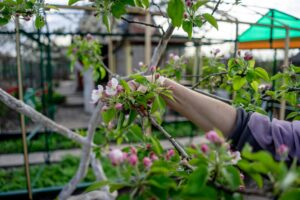
The Importance of Tree Pruning for Healthier Growth
Tree pruning removes dead or diseased limbs that threaten the health of the whole tree. It also reduces the chance of limbs falling in storms or during severe weather conditions.
Pruning during the winter stimulates growth at a time when most insect and pathogen outbreaks are dormant. It also allows your tree to use its energy reserves for healthy growth.
1. Strengthens the Trunk
In addition to removing diseased and dying branches, hiring a professional tree trimming company for proper pruning also promotes healthy growth by strengthening the overall tree structure. Weak limbs are more likely to break under stress, such as during severe weather or heavy snow. Pruning weak limbs before they fail reduces the risk of damage and injury to people or property.
When you hire a tree trimming company to prune a branch, make your first cut just above a lateral bud or pair of buds, which will usually produce an outside branch and provide a good starting point for the new shoot. Slant the cut slightly to the left of center. By doing so, the tree will form a callus at the wound site. This prevents water damage and encourages quick healing.
By hiring a professional tree trimming company and pruning during the winter, you also ensure that disease-causing pathogens are dormant and can’t infect the cut. Removing dead or damaged limbs helps reduce the risk of insect infestation and disease as well. It also improves the appearance of your landscape.
2. Improves Airflow
Incorrect pruning can cause a tree to grow unevenly, and a tree with unhealthy structural integrity is more susceptible to weather damage. It is also more likely to attract pests and spread diseases like blight to healthy parts of the plant. Removing diseased or dead branches and thinning out dense growth within the crown increases air circulation and sunlight exposure, making your tree healthier.
It is best to prune a tree while it is dormant, which can be in mid- to late winter. This allows for the removal of dead or damaged limbs, and it encourages a vigorous burst of new growth in the spring. It is also easier to see problem branches that may need to be removed, including those that cross or rub against each other or the trunk of the tree. When removing any branch, it is important to make the cut just beyond what is called the stem collar, which is a small lip of bark that each branch protrudes from. This helps prevent fungal issues and promotes healing of the wound.
3. Reduces the Risk of Injury
When you prune your trees correctly, you can reduce the risk of injury to people or damage to property. This is because dead or dying branches that are left unattended will require the tree to use its limited energy resources trying to heal their wounds, whereas pruning removes these limbs and allows the tree to focus its energy on healthy growth.
The risk of injury can also be reduced by keeping branches from encroaching on buildings or cars, as well as maintaining proper clearance for power lines and other structures. This can help avoid electrical hazards and decrease the chances of damaged or fallen debris during storms.
When shortening a small branch, it is important to make your cut near a pair of buds or a side shoot. Avoid flush cuts or stub cuts that leave too much wood past the branch collar, as these can cause dieback and open your tree to pests and disease.
4. Promotes Safety
In addition to removing dead and diseased branches, tree pruning promotes safety by removing limbs that are too close to structures or power lines. It also helps prevent damage from high winds and storms that can cause branches to fall.
It also allows the ground beneath the canopy to receive rain and sun, which is important for grass, shrubs, and other plants that can’t grow under a fully grown tree. Pruning can also help improve visibility on sidewalks and roadways by eliminating limbs that obstruct pedestrian or vehicle flow.
It’s vital to prune large and heavy limbs as soon as they begin to break, and especially before the seasons when weather conditions are likely to be more severe. Properly pruning these limbs involves a three-step process that ensures the branch and bark don’t tear when the cut is made. When properly done, this process is called compartmentalization and limits the spread of disease, reduces the weight of the limb, and expedites the healing process.



